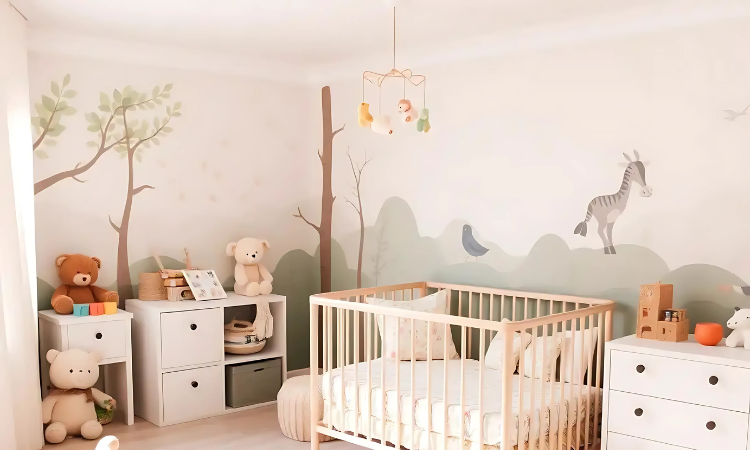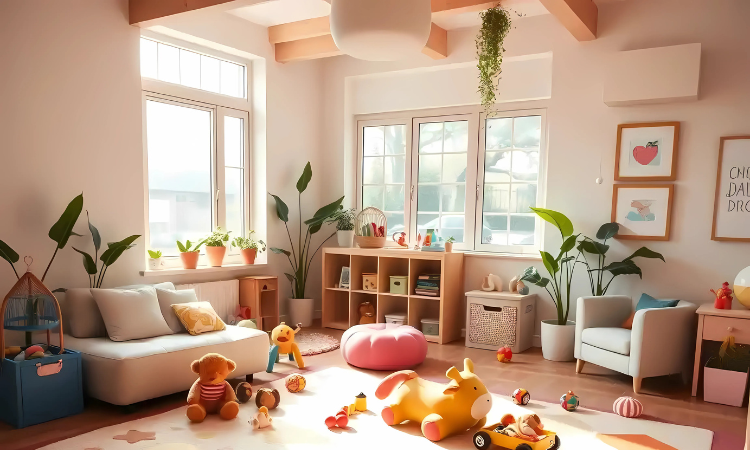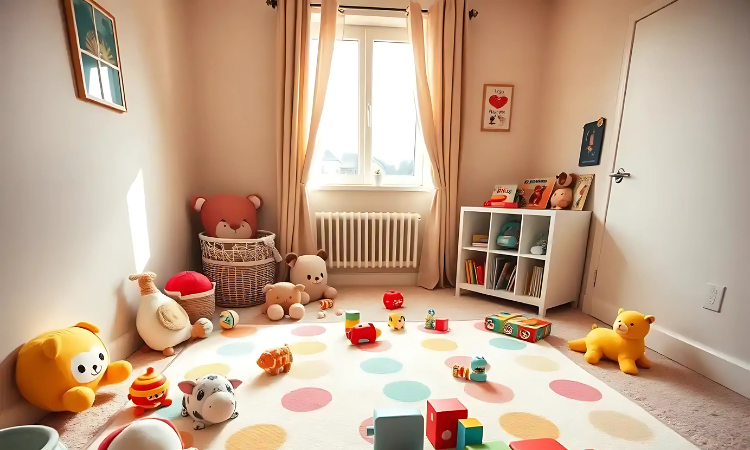
Welcome a baby into your home is one of life’s most exciting milestones. But with great joy comes a myriad of questions, especially for new parents. How do you create a space that’s not only safe and functional but also warm and nurturing? Designing a home—or even just a nursery—that fosters your baby’s growth and development can feel overwhelming.
Don’t worry—we’ve got you covered! From setting up a dreamy nursery to choosing sustainable materials, this guide simplifies the process so you can focus on what matters most—cuddles and milestones.
Designing the Nursery
The nursery is your baby’s first room—a cozy haven where they’ll sleep, play, and grow. The goal? Create a space that feels calming for both parents and baby while being practical and safe.
Choose Calming Colors and Soft Textures
Babies thrive in visually soothing environments.
- Opt for soft, neutral tones like pale blues, soft grays, or gentle pastels to promote relaxation.
- Add warmth with texture—think plush rugs, cozy curtains, or a soft nursing chair. Skip heavy patterns, which can overstimulate.
Arrange Furniture with Safety in Mind
Keep airflow and supervision top-of-mind when positioning furniture.
- Place the crib away from windows, blinds, and radiators to avoid accidents.
- Anchor heavy furniture like dressers to the wall to prevent tipping.
- Leave enough space to move safely, especially during half-asleep nighttime feeds.
Your nursery should focus on simplicity and functionality—less clutter means easier care and a safer space for your baby to explore.

Essential Baby-Proofing Steps
While your newborn may be stationary, they’ll be crawling before you know it! Baby-proofing your home early can save you from last-minute scrambles.
Tackle Common Hazards
Here’s where to start:
- Install baby gates at staircases and between rooms.
- Secure cabinets and drawers with locks to prevent access to cleaning supplies or sharp tools.
- Cover electrical outlets with child-proof plugs to keep little fingers safe.
- Hide cords and wires behind furniture, or use cord organizers.
Get down to your baby’s level—literally! Crawling around gives you a baby’s-eye view of risks you might miss from above.
Selecting Safe and Functional Furniture
Choosing baby furniture isn’t just about aesthetics—it’s about safety and practicality. Here’s what to look for.
The “Must-Haves”:
- Check for cribs that meet CPSC safety standards. Ensure bars are securely spaced, and avoid drop-side cribs.
- Look for tables with safety straps and raised edges to keep your wriggly baby secure. Keep everything you need within arm’s reach—never leave your baby unattended.
- Opt for baskets or child-friendly bins to keep toys and essentials organized (and out of your baby’s mouth).
Pro Tips for Furniture Arrangement
- Keep heavier items low and secure with wall anchors to prevent tipping.
- Arrange your setup so essentials are close to the crib or glider, minimizing disruptions during nap time—or midnight diaper changes!
Creating a Healthy Indoor Environment
Your baby’s delicate system deserves the healthiest space possible. Here’s how to ensure better air quality and reduce irritants at home.
Improve Air Quality
- Use a HEPA air purifier to reduce allergens, pet dander, and dust.
- Consider a humidifier to maintain optimal moisture for your baby’s skin and breathing, especially in winter.
- Say no to smoking. Keep your space free of candles, smoke, or harsh air fresheners.
Safe Cleaning and Storage
Cleanliness is key for a baby-safe home.
- Use non-toxic cleaners to disinfect surfaces, bottles, and toys. Look for eco-friendly, fragrance-free options.
- Store soaps, detergents, and medications high up or locked away.
Nurturing Sensory Development
Did you know your baby’s environment plays a major role in sensory development? Here’s how to blend design with growth opportunities.
Sensory-Friendly Elements
- Lighting
- Use a dimmable nightlight or warm-toned lamp for gentle lighting during nighttime feeds.
- Music and Sound
- Consider a sound machine or soft ambient music to calm your baby (and yourself).

Encourage Exploration
- Organize toys by type—soft books in one basket, stacking rings in another.
- Use open shelving to showcase toys, making exploration playful and accessible.
Sustainability and Eco-Friendly Design
Your baby deserves a safe space—and so does the planet. Start your eco-friendly parenting journey with conscious choices!
Select Non-Toxic and Sustainable Materials
- Look for furniture made from sustainably sourced wood and painted with non-toxic, water-based paint.
- Switch to organic bedding and clothing, which are free from harmful dyes and chemicals.
Reduce Waste
- Opt for multi-functional furniture, like a convertible crib that grows with your baby.
- Repurpose items, such as a stylish chair from an older sibling’s nursery or secondhand wicker bins for toys.
Every little choice adds up—for your baby, your home, and the planet’s health!
Designing the Future of Safety and Comfort
A safe, nurturing environment for your baby isn’t just about aesthetics—it’s about creating a sanctuary of growth, safety, and love. From thoughtful furniture arrangements to eco-friendly choices, every decision matters.
Your baby’s first year will be filled with milestones, laughter, and moments you’ll cherish forever. By designing the perfect space, you’re setting the stage for memories that will last a lifetime.
What are your top tips for creating a baby-friendly space? Share your thoughts and experiences in the comments below—we’d love to know!
Frequently Asked Questions (FAQ)
Q: What are the most important elements to consider when designing a baby-friendly space?
A: Safety comes first! Focus on baby-proofing furniture with corner guards, securing heavy items to walls, and choosing non-toxic materials. Comfort and practicality are also essential—opt for washable fabrics, durable furniture, and plenty of storage for toys and essentials.
Q: Are eco-friendly choices more expensive?
A: Not necessarily! Many sustainable options, like using secondhand or upcycled furniture, can save money. Additionally, investing in high-quality, long-lasting items may cost more upfront but will often pay off in the long run.
Q: How do I balance aesthetics with functionality in a nursery?
A: Start with a cohesive color palette or a theme you love, then prioritize furniture and decor that serve dual purposes. For example, a stylish dresser can double as a changing table, and baskets can be both decorative and functional for storage.
Q: When should I start planning the nursery?
A: It’s never too early to brainstorm ideas, but most parents find that starting the actual setup during the second trimester allows enough time to shop, assemble furniture, and make adjustments before the baby arrives.
Have more questions? Drop them in the comments, and we’ll be happy to help!






